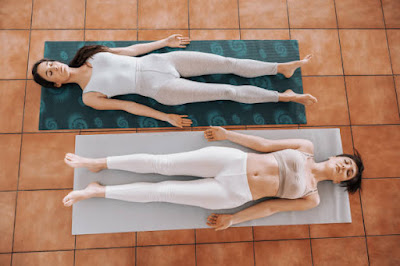If done slowly and with attention on the breath, many Asanas and Hatha Yoga Kriyas provide good bodily relaxation as a result of their practice.
- In the proper practice of Yoga, rapid movement and excessive muscular activity should be avoided.
- There is a contemporary Yoga school that promotes "Athi" Yoga, or "Stress Yoga." This school is more appropriately linked to calisthenics or Vyayama.
Moderate Asana and Pranayama exercise should leave one with a feeling of physical well-being and, when ready to be active again, a sense of a healthy re-bound from the prior relaxed state.
- Kaya Kriya is a perfect example of a Hatha Yoga relaxing technique.
- The supine Tala Kriya,
- And Dridha Kriya are two more that I strongly suggest.
Both of these Kriyas (or acts) have a standing equivalent.
Tala Kriya is a stretching motion that may be performed while laying supine on your back or upright.
The supine posture is the one we're concerned with right now.
The Palmyra tree is known as "Tala."
1. Hollow out the back by elevating the lower spine while completing an incoming breath while resting supine in Shava Asana.
- On the outgoing breath, the back is reclined to the floor.
- Abdominal breathing accentuates the abdominal region, resulting in the greatest potential lower back lift.
- Instead of lifting the buttocks or shoulders off the floor, just arch your back while resting supine and inhaling deeply.
2. Wiggle your hips and knees downwards while resting supine to stretch your lower back.
- Imagine your "buttocks are feet" and you're "walking away from yourself," extending the lower back as far as possible while the upper back and shoulders remain motionless.
- The body starts to drag the floor down after a few motions.
- Stop the lower motion and isolate the hips by crawling "upwards" with the shoulders until the middle and upper back are stretched to the point where the hips are being dragged out of the initial posture.
- Stop at that moment and continue rotating your head.
3. Gradually move the head from side to side, gently pulling the neck upwards and out of the confined position formed by Part 2 above.
4. Raise your arms over your head and place the backs of your hands on the floor.
- Do deep, focused breathing, pressing down with the toes and up with the fingers to the held-in-breath condition, then releasing all tension on the outgoing breath.
A useful practice for Tala Kriya is to take a three-part breath, pressing down on the abdominal section with the legs and feet, extending the mid-body with intra-costal breathing, and pushing the chest and arms upwards with the high breath.
- Repeat each of the components six or seven times more, or until you feel physically relaxed.
You may also want to read more about Gnani Yoga here.
You may also want to read more about Kundalini Yoga here.
You may also want to read more about Hinduism here.




